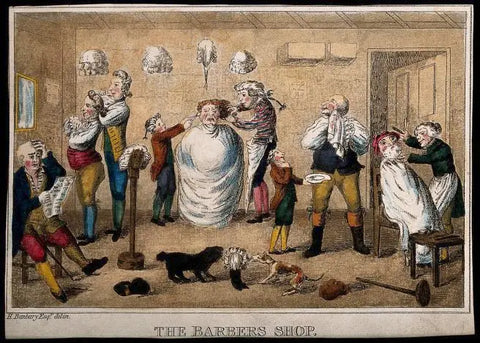Nowadays, barbers are exclusively facial stylists and barbershops are homes for haircuts and endless debates. This hasn’t always been the case, historically barbers have played multiple roles at once including surgeon, dentist, tattooist, embalmer, and wigmaker. This is their story, this is the story of the barber-surgeon.

Ancient Egyptians, Greeks, and Romans are all examples of civilizations that utilized barber-surgeons although the first documented multi-tasking barbers have been found to be from around 1000 A.D. Barbers were commonly found at monasteries as they shaved the monks’ heads and faces. Surgical procedures and operations were considered dirty and lowly by monk doctors who passed these responsibilities to their barber brethren.
The golden age for barber-surgeons was undoubtedly the Middle Ages and Renaissance, prior to the Industrial Revolution which moved Europe towards systematization and centralization. At this time, barber-surgeons were quasi medical practitioners who not only cut hair but also conducted surgery (even on battlefields), extracted teeth, and performed enemas. They normally had no formal education and instead learned their trade apprenticing under a senior fellow.

Most famously, barber-surgeons were in charge of bloodletting, a process that required sharp instruments like scissors and razors and was done with the thinking that you replace old, “bad” blood with fresh, healthy blood. In fact, the famous red and white barber’s pole found outside barber shops around the world is meant to reflect the blood and napkins used to clean up during bloodletting.

Originally, universities did not teach surgery as it was considered manual labor and nothing more. This changed with the rise of secular universities that led to an increased study of medicine and the human anatomy. From then on, academic surgeons wore long robes to signify their status while barber-surgeons wore short ones and were referred to as “surgeons of the short robe.”
Some barber-surgeons enjoyed fortune and fame. When this happened, they would be invited to serve the nobles and wealthy. Often these barber-surgeons would eventually open up exclusive boutiques and salons in Paris, London, Milan, and more.

In 1745, King George II established the London College of Surgeons which signalled the end of barber surgeons although a place in Melbourne upto the 1950s was willing to cut your hair and pull your teeth at the same time. By then, surgeons went to university while barbers tended to the hair and nails. The last practicing barber-surgeon died in 1821 in England and no, it wasn’t Sweeney Todd!

